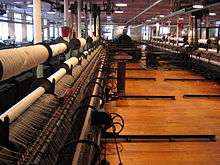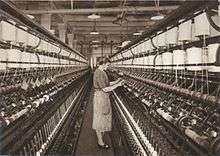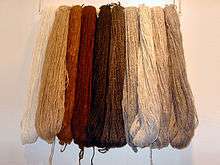Spinning (textiles)
Spinning is the twisting together of drawn-out strands of fibers to form yarn, and is a major part of the textile industry. The yarn is then used to create textiles, which are then used to make clothing and many other products. There are several industrial processes available to spin yarn, as well as hand-spinning techniques where the fiber is drawn out, twisted, and wound onto a bobbin.
Types of fibre
Artificial fibres are made by extruding a polymer through a spinneret into a medium where it hardens. Wet spinning (rayon) uses a coagulating medium. In dry spinning (acetate and triacetate), the polymer is contained in a solvent that evaporates in the heated exit chamber. In melt spinning (nylons and polyesters) the extruded polymer is cooled in gas or air and sets.[1] All these fibres will be of great length, often kilometers long.
Natural fibres are from animals (sheep, goat, rabbit, silkworm), minerals (asbestos), or plants (cotton, flax, sisal). These vegetable fibres can come from the seed (cotton), the stem (known as bast fibres: flax, hemp, jute) or the leaf (sisal).[2] Without exception, many processes are needed before a clean even staple is obtained. With the exception of silk, each of these fibres is short, being only centimetres in length, and each has a rough surface that enables it to bond with similar staples.[2]
Artificial fibres can be processed as long fibres or batched and cut so they can be processed like a natural fibre.
Methods
Ring spinning is one of the most common spinning methods in the world. Other systems include air-jet and open-end spinning, a technique where the staple fiber is blown by air into a rotor and attaches to the tail of formed yarn that is continually being drawn out of the chamber. Other methods of break spinning use needles and electrostatic forces.[3]
The processes to make yarn short-staple yarn (typically spun from fibers from 0.75 to 2.0") are blending, opening, carding, pin-drafting, roving, spinning, and—if desired—plying and dyeing. In long staple spinning, the process may start with stretch-break of tow, a continuous "rope" of synthetic fiber. In open-end and air-jet spinning, the roving operation is eliminated. The spinning frame winds yarn around a bobbin.[4] Generally, after this step the yarn is wound to a cone for knitting or weaving.
In a spinning mule, the roving is pulled off bobbins and sequentially fed through rollers operating at several different speeds, thinning the roving at a consistent rate. The yarn is twisted through the spinning of the bobbin as the carriage moves out, and is rolled onto a cop as the carriage returns. Mule spinning produces a finer thread than ring spinning.[5] Spinning by the mule machine is an intermittent process as the frame advances and returns. It is the descendant of a device invented in 1779 by Samuel Crompton, and produces a softer, less twisted thread that is favored for fines and for weft.
The ring was a descendant of the Arkwright water frame of 1769 and creates yarn in a continuous process. The yarn is coarser, has a greater twist, and is stronger, making it more suitable for warp. Ring spinning is slow due to the distance the thread must pass around the ring. Similar methods have improved on this including flyer and bobbin and cap spinning.
The pre-industrial techniques of hand spinning with spindle or spinning wheel continue to be practiced as a handicraft or hobby, and enable wool or unusual vegetable and animal staples to be used.
 Mule spinning
Mule spinning Mule spinning
Mule spinning- Ring spinning
 Ring spinning
Ring spinning
History and economics
Hand-spinning was a cottage industry in medieval Europe, where the wool spinners (often women and children) would provide enough yarn to service the needs of the men who operated the looms. Fabrics wider than an arm-span were produced by paired weavers, stationed at each side of the loom, passing a bobbin or shuttle of yarn (the weft) between them. In Britain, the introduction of the flying shuttle sped up the weaving process, and enabled the operation of a broad loom by a single weaver. This halved the number of weavers required to produce a given quantity of broadloom fabric on a single loom. Effectively, it more or less doubled woven output and the demand for spun yarn. The subsequent invention of the spinning jenny water frame helped meet this demand through mechanisation. Its technology was specialised and costly, and employed water as motive power. Spinning and weaving as cottage industries were displaced by dedicated manufactories, developed by industrialists and their investors; the spinning and weaving industries, once widespread, were concentrated where the sources of water, raw materials and manpower were most readily available, particularly West Yorkshire. The British government was very protective of the technology and restricted its export. After World War I the colonies where the cotton was grown started to purchase and manufacture significant quantities of cotton spinning machinery. The next breakthrough was with the move over to break or open-end spinning, and then the adoption of artificial fibres. By then most production had moved to India and China.
During the industrial revolution, spinners, doffers, and sweepers were employed in spinning mills from the 18th to 20th centuries. Many mill owners preferred to employ children due to their small size and agility.
References
- ↑ Collier 1970, p. 33
- 1 2 Collier 1970, p. 5
- ↑ Collier 1970, p. 80
- ↑ Collier 1970, pp. 71
- ↑ Saxonhouse, Gary, "Technological Evolution in Cotton Spinning, 1878–1933" (PDF), SST Seminars, Stanford University, archived from the original (PDF) on July 16, 2011
Bibliography
- Collier, Ann M. (1970), A Handbook of Textiles, Pergamon Press, p. 258, ISBN 0-08-018057-4
External links
| Wikimedia Commons has media related to Spinning. |

